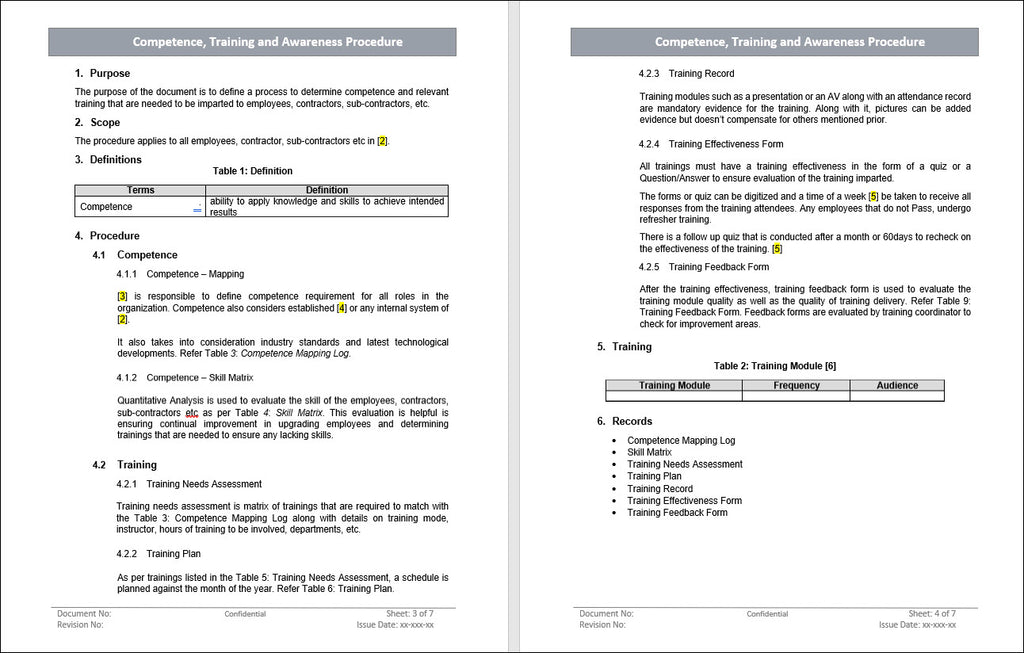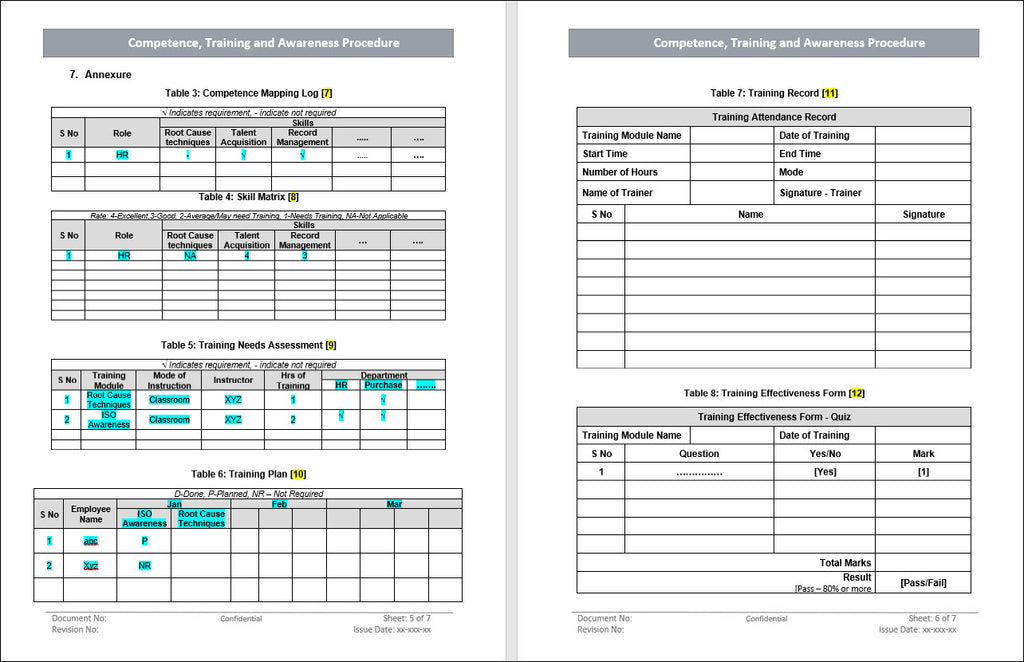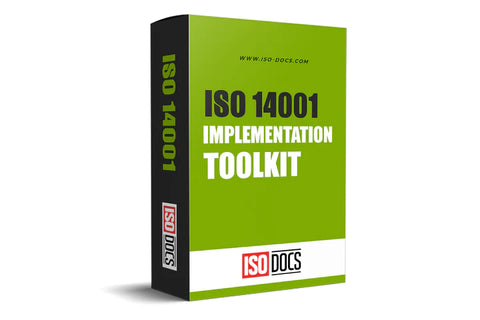Competence Training And Awareness Procedure Template Donwload
Competence training and awareness is a procedure through which individuals learn about and become familiar with the concepts and requirements of ISO 14001:2015. The goal of this training is to ensure that employees understand their roles and responsibilities in the organization's environmental management system (EMS) and are aware of the potential environmental impacts of their work.

What Should Be Included In A Competence Training And Awareness Procedure?
A competence training and awareness procedure should be appropriate for the size and complexity of the organization, the nature of its activities, products, and services, and the environmental aspects and impacts it may cause. The Procedure should include the following elements:
- A description of the process for developing and delivering competence training and awareness.
- An identification of the employees who require training and awareness.
- A description of the training and awareness content - A description of how the training and awareness will be delivered.
- A description of how the training and awareness will be evaluated.
- A description of how the competence of employees will be maintained over time.
ISO 14001 Awareness Procedure
It is a requirement of ISO 14001:2015 that the organization shall develop and implement a competence training and awareness procedure. The Procedure shall ensure that all relevant persons are aware of:
- The importance of environmental management.
- Their contribution to the effectiveness of the EMS.
- Their roles and responsibilities.
- The nature of the environmental aspects and impacts are relevant to their work.
- The consequences of failure to adequately control environmental factors and impacts.
- The changes must be made and the actions required to implement the EMS.
- The importance of communicating with relevant interested parties.
- The benefits of improved environmental performance.

Importance of Competence Training And Awareness Procedure
- Organizations implementing ISO 14001 can realize several benefits, including reduced environmental impact, improved environmental performance, and cost savings. To realize these benefits, organizations must have a competent and aware workforce.
- The standard is designed to apply to all types of organizations, regardless of size, location, or type of activity. However, it is particularly relevant for organizations that directly impact the environment, such as manufacturing companies.
- Organizations should also ensure that all employees know the EMS and how it affects their work. Awareness-raising activities include displaying posters, distributing information leaflets, or holding briefings. By increasing the understanding of the EMS among all employees, organizations can ensure that everyone is playing their part in protecting the environment.
- The ISO 14001 standard requires organizations to have a procedure for ensuring that personnel is competent and aware. This procedure should specify how training and awareness-raising activities will be planned, implemented, and monitored. It should also identify who is responsible for each activity. By following this procedure, organizations can be sure that they are making the most of their workforce's skills and knowledge and that everyone is playing their part in protecting the environment.
Environmental Training and Awareness Program
An Environmental Training and Awareness Program (ETAP) is a great way to engage employees in environmental protection and sustainability initiatives. By raising awareness of environmental issues and providing training on reducing environmental impacts, ETAPs can help businesses save money, conserve resources, and improve their environmental performance.
However, launching a successful ETAP requires careful planning and execution. This article provides tips on developing and implementing a practical environmental training and awareness program for your business.
- Define your ETAP's purpose- Before developing an environmental training and awareness program, you need to determine what you hope to achieve with the program. For example, do you want to educate employees about environmental issues? Train them on how to reduce their environmental impact. Engage them in sustainability initiatives. Once you have a clear purpose for your ETAP, you can start developing the program.
- Identify your target audience- Whom will you target with your environmental training and awareness program? Employees? Management? Customers? Each group will have different needs and interests, so it is essential to tailor your ETAP to your target audience.
- Develop educational materials- Your ETAP should include educational materials that provide information on environmental issues and how they can be addressed. The materials should be appropriate for your target audience and aligned with the purpose of your ETAP. For example, if you want to educate employees about environmental issues, you might develop an e-learning course or an informative pamphlet. If you're going to train employees on reducing their environmental impact, you might create a training manual or an online tutorial.
- Deliver the program- Once you have developed the materials for your ETAP, it is time to deliver the program. Depending on your target audience and the resources available, you might provide the program in person, online, or a combination of both. For example, if you are targeting employees.
Instructions To Use The Document

All yellow indicated numbers in the Competence training and awareness procedure need action. Below are details
1. Provide the Revision History of the document
- Revision Number: in the order of 00,01,02, etc
- Date: Revision Date of Document in dd-mmm-yyyy
- Prepared By: Name of the person who prepared the document
- Reviewed By: Name of the person who reviewed the document after revision
- Approved By: Name of the person who approved the document after revision
- Description: Describe the revision
3. HR/Designated Personnel
4. Type either of the below as applicable, IMS/QMS/EMS/OHSMS
- IMS – Integrated Management system i.e ISO 9001:2015, 14001:2015, 45001:2018 all
- QMS – Quality Management system i.e., ISO 9001:2015
- EMS – Environmental Management system i.e., ISO 14001:2015
- OHSMS – Occupational Health and Safety Management system i.e., ISO 45001:2018
5. Modify as per organization
6. Add training modules as per organization requirement
7. Competence Mapping Log, sample filled for reference
8. Skill Matrix, sample filled
9. Sample Filled for reference, may be modified as per requirement
10. Training Plan: Provide a schedule as and when the training will be executed. It can be prepared annually or quarterly as per the feasibility of the organization
11. Training Record: Training Attendance Record is ensured by filled details.
12. Training Effectiveness Quiz: Questions be prepared to have answers in the form of Yes/No or can be modified as per organization preference. The ultimate aim is to ensure a proper outcome, such as Pass/Fail.
13. Training Feedback Form: The filled sample form may be modified as per the organization’s preference. It may be kept anonymous. Feedback forms are evaluated at the end to determine any improvements needed.



